The more different flocks, the more rooster breeds that keepers require.
Though roosters don’t lay eggs, they still have many benefits for the flock and habitat. Many keepers raise them mainly for breeding, meat, display, and sports.
If you need to install a rooster in your backyard, here are the best breeds that offer several purposes.
1. Rhode Island Red
This is a traditional breed of American origin with red plumage ranging from a lustrous deep red to almost black and a black tail.
Rhode Island Red roosters can have single or rose-comb and red earlobes and wattles.

They weigh 8.5 lbs and reach butcher size in 5 months.
The poultry keepers enjoy raising these roosters for their abilities including hardy, disease-resistant, and fertilizing eggs.
You can expect the birds to be excellent for beginners and dual-purpose chickens.
Temperament: Generally docile but can be protective
Egg Fertility: Good for breeding
Ideal for: Egg-laying flocks and meat production
2. Sussex
Sussex roosters have a rectangular build and deep broad body with broad shoulders, straight breastbones, and long, wide backs.
They are hardy birds with a regal appearance in light, red, speckled, coronation, buff, brown, silver, and white. The roosters can weigh 9 lbs for meat production.
For this weight, you may need to raise chickens for 16-20 weeks and then butcher.

But if you want to roast and don’t want the birds to be tough, you can harvest them in 6 – 9 weeks.
Besides, Sussex are alert, calm, attractive, and good foragers.
Temperament: Assertive but manageable
Egg Fertility: Great for breeding high-producing hens
Ideal for: Cold climates and dual-purpose farms (Breeding and meat)
3. Orpington
I love this breed for its large, broad body and deep chest, which helps produce heavyweight weighing 10 lbs.
Orpington roosters are a large curved or round shaped birds with a small head and medium single cone. They display broad, short body with a low stance.
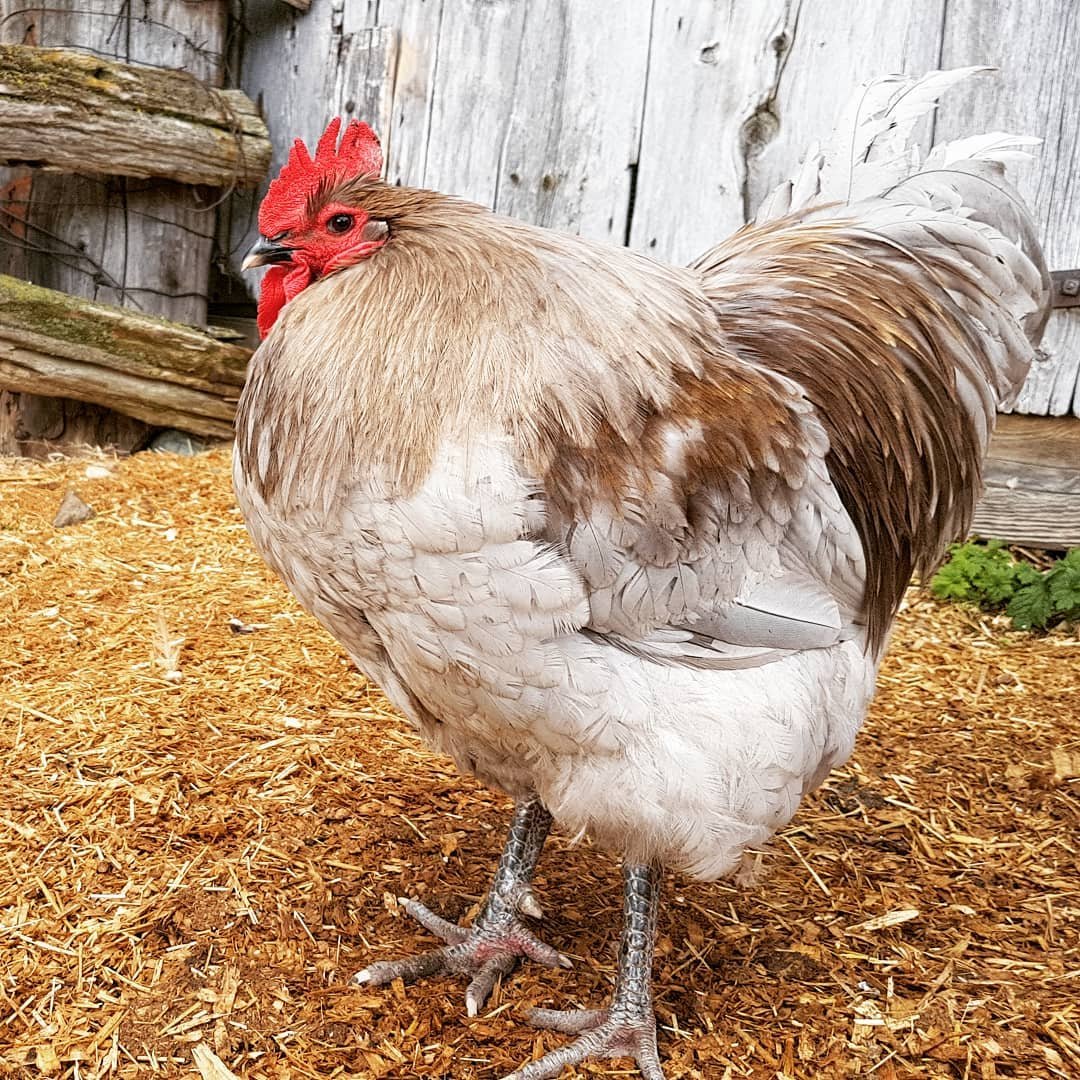
Their legs are almost hidden due to soft, profuse feathering.
Also, their fluffy plumage gives the Orpington a full appearance in blue, black, buff, white, partridge, and cuckoo.
The dual-purpose breed chickens are calm, gentle, docile, and not flighty due to their giant size.
Temperament: Gentle and friendly, good with hens
Egg Fertility: High fertility rate
Ideal for: Meat production and breeding, family-friendly farms, and mixed flocks
4. Leghorn
You will be surprise to know these birds to be highly active and great at fertilizing eggs, leading to high hatchability.
Leghorn roosters are small chickens with red combs, lobed wattles dangling below the beak, and high-arched tails.
They come in v shaped and long and slender body in multiple plumages including white, red, brown, black, buff, barred, and silver.

They only weigh around weigh 7 lbs so you cannot expect them to have large meat. But they can be excellent for egg-laying flocks.
Besides, leghorns are loudmouth roosters with great style and a penchant for pranks in the backyard.
Temperament: Energetic, flighty, alert
Egg Fertility: High fertility rate
Ideal for: Farms focusing on egg production, free-range setups
5. Brahma
You can imagine brahmas with heavily feathered birds from head to shank, not even sparing the feet.
Yes, they are densely well-fitted birds in several shades, such as light, buff, and dark.
They are large and heavy birds with broad and steady and V-shaped body. Their broad, muscular build with a deep, wide chest make the roosters appear in majestic look.
12 to 18 lbs is a large number for meat production so brahmas make great broiler chickens.
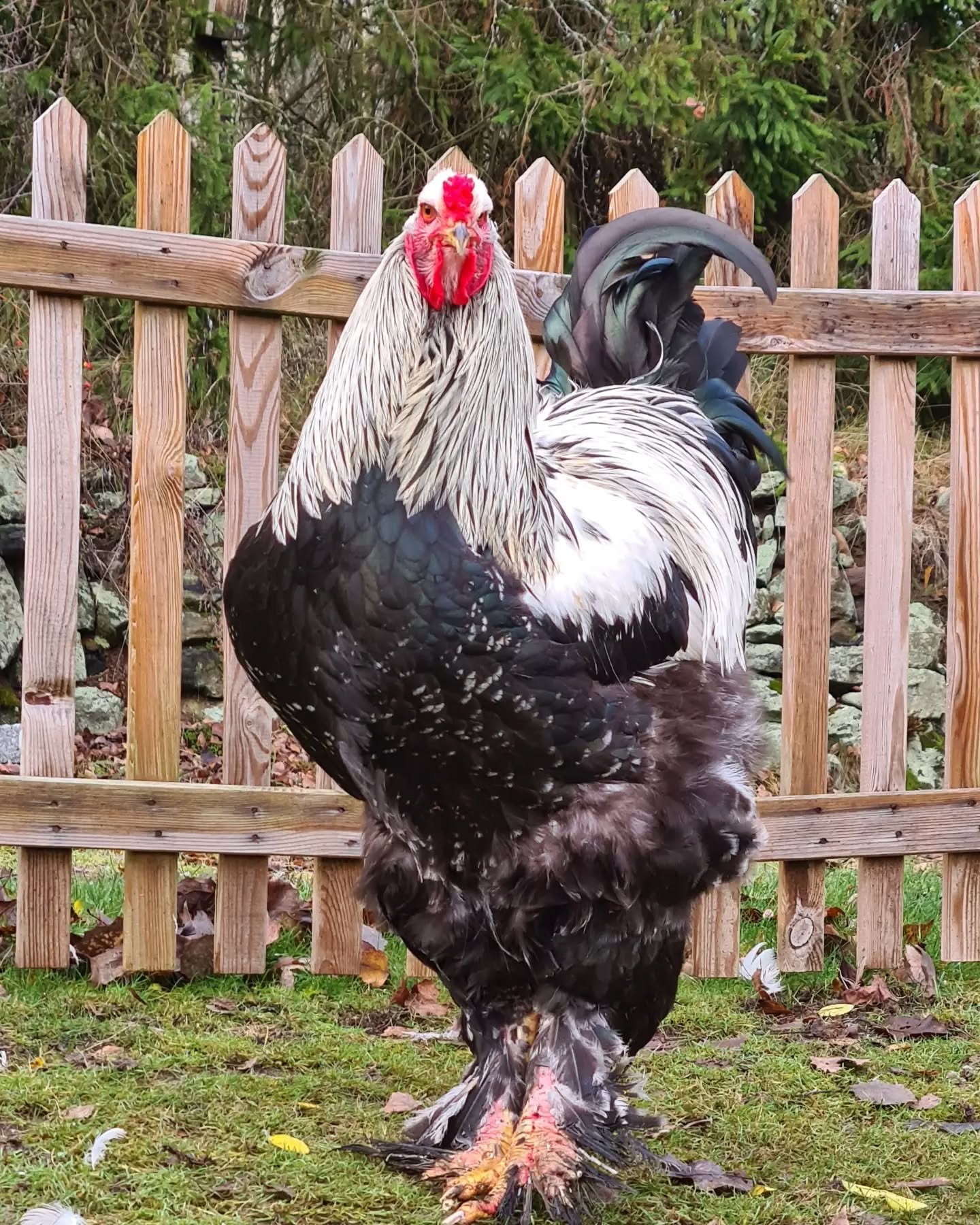
They become ready to butcher in 8-10 weeks and for breeding hens in 4-6 months.
Brahmas are giant so they cannot fly and remain friendly with humans and flocks.
Temperament: Docile and non-aggressive
Egg Fertility: Reliable
Ideal for: Cold weather, meat production, and ornamental purposes
6. Cochin
Cochins are large birds that look like puffy, rounded hearts.
They boast red crowns and wattles, large feathered legs, and low stance body, and bushy tails. Also, chickens have heavy plumage in white, black, blue, laced, brownish-gold, and buff.

These roosters also make great broilers for meat weighing 10 – 12 lbs.
You can harvest them in 6 months. I know they are slow to grow and mature in one year.
Cochins are friendly, calm, gentle, and good with hens.
Temperament: Extremely docile
Egg Fertility: Moderate
Ideal for: Cold weather and backyard pets (ornamental purpose)
7. Marans
If you’re thinking of chickens laying colored eggs, marans are one of them. They help produce dark brown eggs when paired with hens.
Generally, marans are black, black copper, white and wheaten.
But marans roosters also look like Rhode Island Red with multi color feathers of brick red, black, and orange.
They have a large, strong, and rounded body, weighing 8 – 10 lbs.

They are not very loud and make docile and calm birds.
But you can expect them to be active and great for free-ranging in rough terrain. The roosters are also disease-resistant and excellent for cold climates.
Temperament: Somewhat assertive but manageable
Egg Fertility: Good for specialty egg production
Ideal for: Those wanting unique egg colors, meat production
8. Plymouth Rock
I like Plymouth rock roosters for their breeding ability, meat, and temperament.
They are originally barred with black and white feathers but come in other shades, including white, buff, blue, columbian, partridge, and silver penciled.

You can tell them by a long, moderately deep, full breast and broad back.
These chickens also have a single comb, ear lobes, and a bright yellow bill.
Plymouth rocks mature in 6-8 months, but keepers can harvest them in 16 weeks. You can expect them to grow around 9 – 10 lbs.
They make a dual-purpose breed with a friendly nature.
Roosters are not aggressive and boast reliable fertility and good protection for hens.
Temperament: Friendly and calm
Egg Fertility: Excellent; keeps hens productive
Ideal for: Backyard flocks and family-friendly homesteads
9. Wyandotte
Wyandotte roosters are harvested at the age of 3 months, but I think we should wait until they are around 5 – 6 months. The chickens get their mature weight around 8 – 9 lbs only that time.
What I like about them is their attractive plumage with a balanced temperament.
Their variety includes golden laced, white, black, buff, and columbian shades.

The roosters have a medium-sized body with deep, full, and well round breasts and a wide back. The clean leggings, laced feathers, and rose combs are also additional features.
You can expect them to crow around 5 months of age.
They are friendly and docile and enjoy free range and foraging in open ground.
Temperament: Friendly but assertive
Egg Fertility: High fertility rate
Ideal for: Cold regions, ornamental purposes
10. Langshan
Langshans are good foragers and make calm, friendly, nonaggressive, and easily tamed chickens.
But they also make no complaints against confinement. These chickens belong to one of the tallest breeds with feathered legs.

Look at this large black rooster with a U-shaped body, long legs, and a large, fanned tail. They can also be white or blue.
Their white skin and full breasts produce white meat that is rich in flavor. You can expect these birds to weight around 9 – 10 lbs.
Temperament: Docile but confident
Egg Fertility: High
Ideal for: Dual-purpose farming
11. American Game Fowl
This is for hobby farms where keepers like to experiment with unique flocks for different purposes other than meat production.
American Game roosters are hardy and muscular birds originally known for sports or cockfighting.
Keepers compliment for their strength and agility. Also, their active and alert nature makes them excellent protectors for free-range flocks.
The game breed has a sleek and athletic build. They are only around 6 lbs, so they can fly a few distances.

Besides, these standard-sized birds grow a range of plumage colors and roosters with long sickle feathers. I had streaky breasted orange-red rooster a few years back.
I suggest you raise American Games in spacious pasture or free range to forage and prevent aggression.
They are not for beginners so, keepers need to have good experience to handle and control these birds. Also, they are good alternatives to Shamos and Malays.
Temperament: Confident, hardy, and highly alert; can be aggressive towards other roosters
Egg Fertility: Good
Ideal for: Sports, ornamental purposes, and free-range protection
12. Jersey Giant
Jersey Giants make great table birds for even a large group or family.
They have medium to long, wide and deep body to appear like a square birds. Their additional appearance include flat back and short tail.
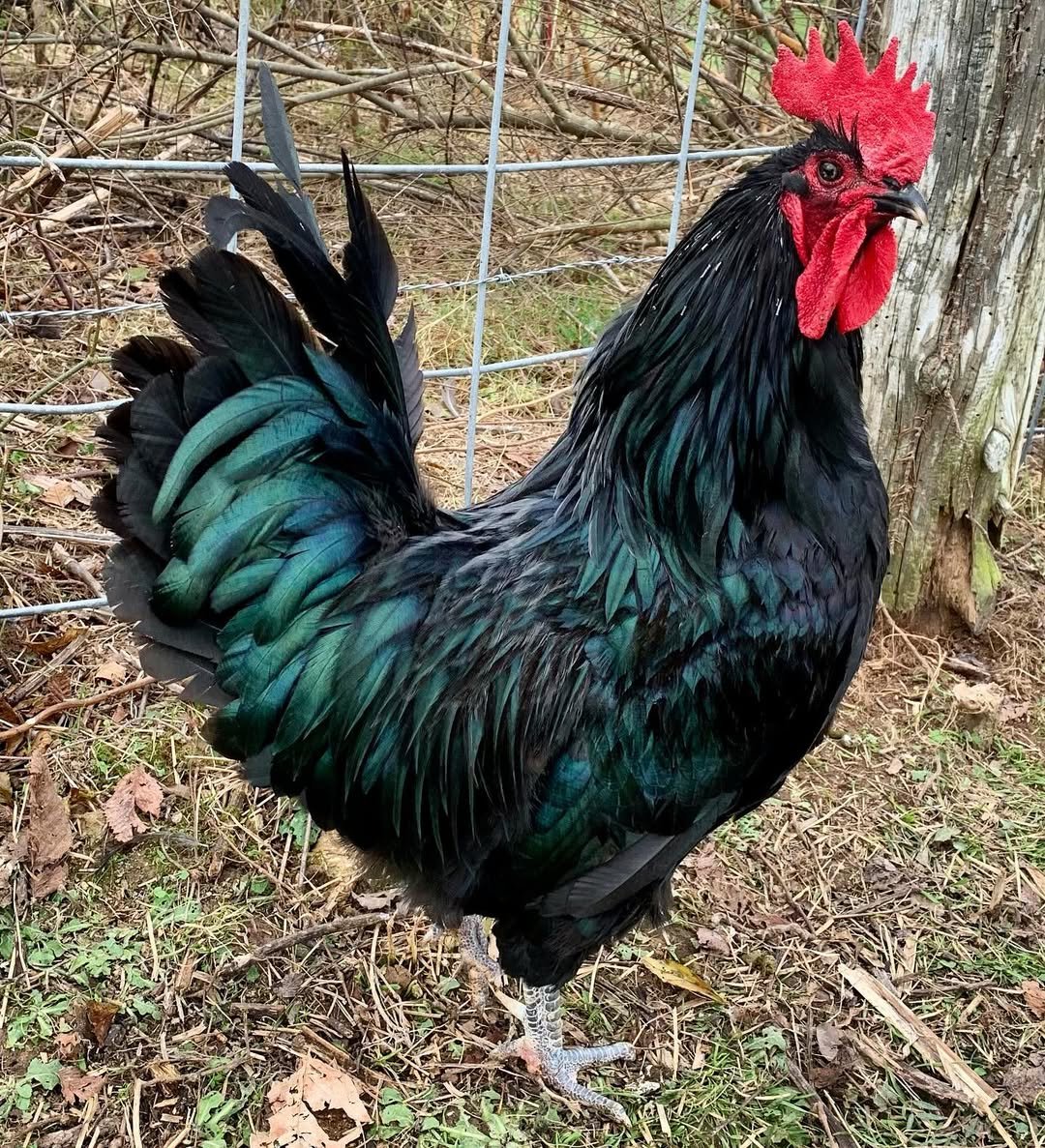
Keeprers prefer these roosters to be meat birds that weigh 13-15 lbs.
But they need 6-8 months for full growth.
Due to their heavy weight, they cannot fly. But if they find something attractive, the roosters can jump over the fence.
Jersey Giants are calm and docile and nice to flock mates including hens. These friendly chickens like to cuddle with their owners.
Temperament: Gentle despite its size
Egg Fertility: Reliable
Ideal for: Meat production and large homesteads
13. Dominique
Dominiques are simple birds with black and white barring all over their body. This coloration of feathers makes it less attractive to predators.
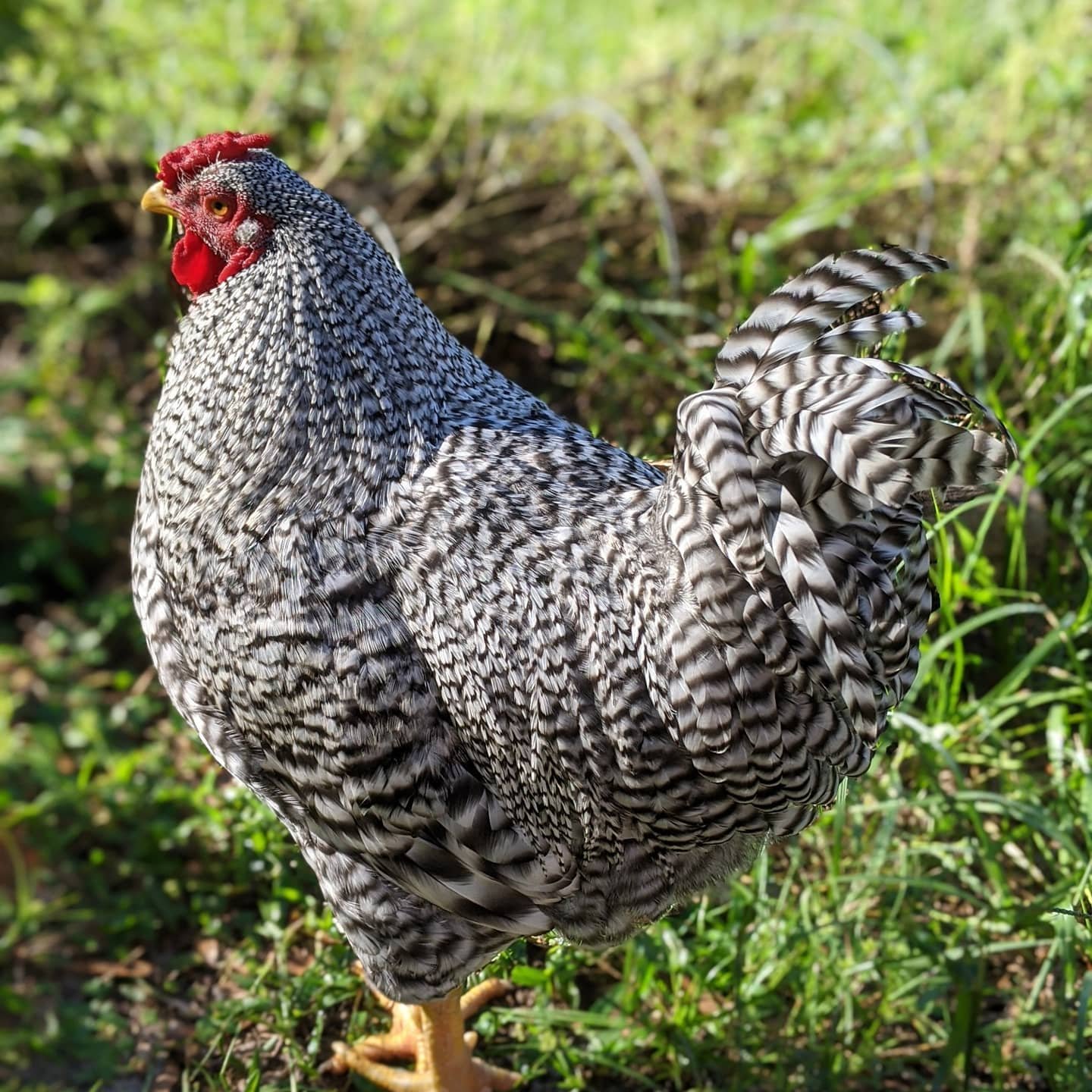
They are medium-sized chickens with small rose combs with a “U” shaped back and full, long, and full feathers.
Their heavy or full plumage helps chickens survive in cold climates. The feathers can also be used for pillows and featherbeds.
Besides, Dominique roosters are active, hardy, productive, and friendly.
They grow around 7 lbs and are ready to butcher in 5-6- months.
Temperament: Calm and adaptable
Egg Fertility: Consistently good
Ideal for: Cold climates and meat-yielding farms
14. Yokohama
I tell you, Yokohamas are simply amazing to watch around the backyard among the other breeds.
They provide striking display through their long trailing saddle feathers and long tails.
These small birds have a pea- or walnut-comb, yellow beak, and shanks.
The roosters have pure white or white with red saddle feathers, making them great ornamental chickens in urban settings.
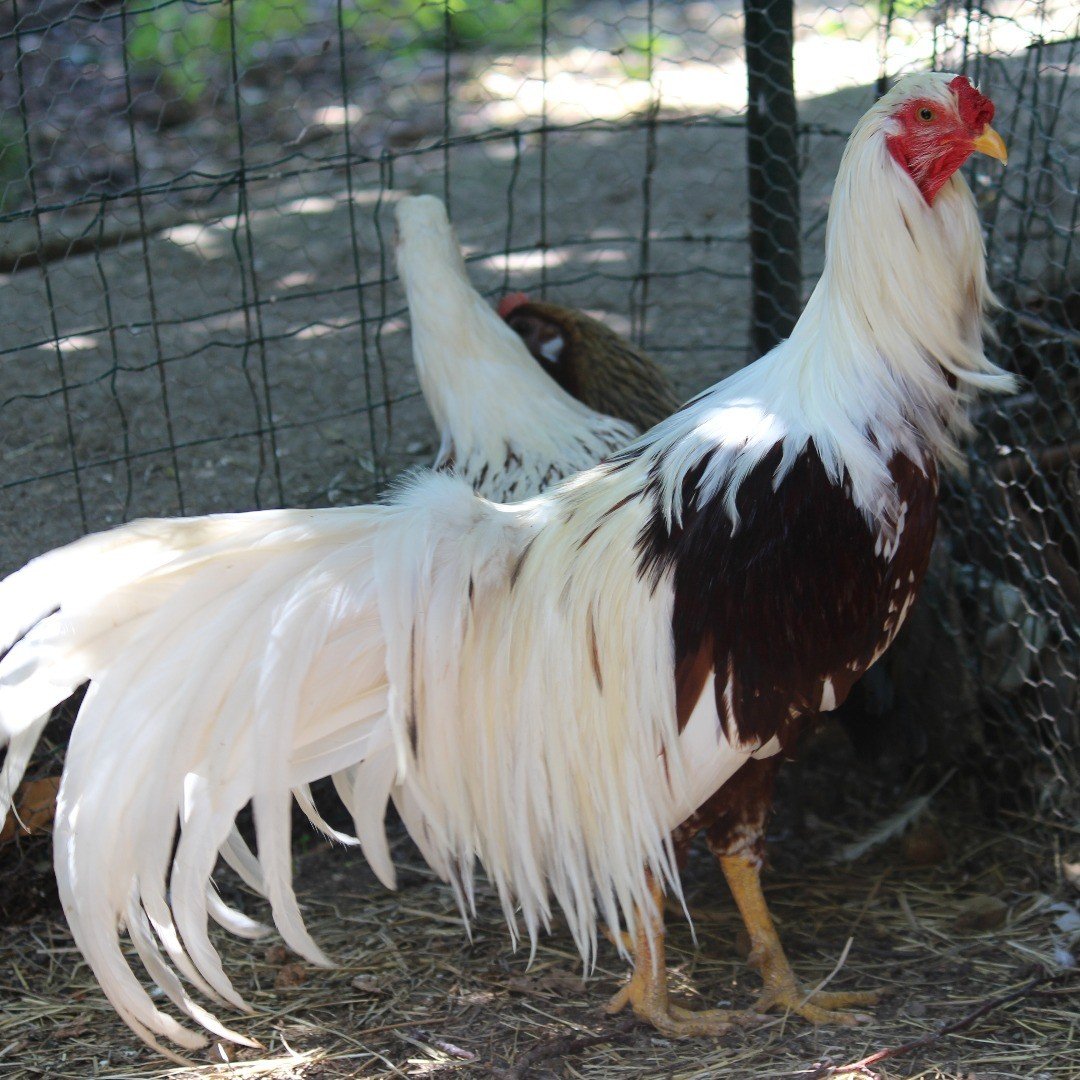
I find some common Yokohamas with a sleek white body, red feathers on the shoulders, and upright carriages, offering game-like appearance.
Besides, they are small birds weighing 4.5 lbs but can grow up to 7 lbs.
You can expect them to be docile, friendly, attractive, and quiet birds.
Temperament: Gentle but needs special care
Egg Fertility: Moderate
Ideal for: Exhibition purposes
15. Faverolles
This is another ornamental breed but can produce a good amount of meat.
Faverolles are unique roosters with a beard and muffs, so their wattle and ears are hidden or barely visible.
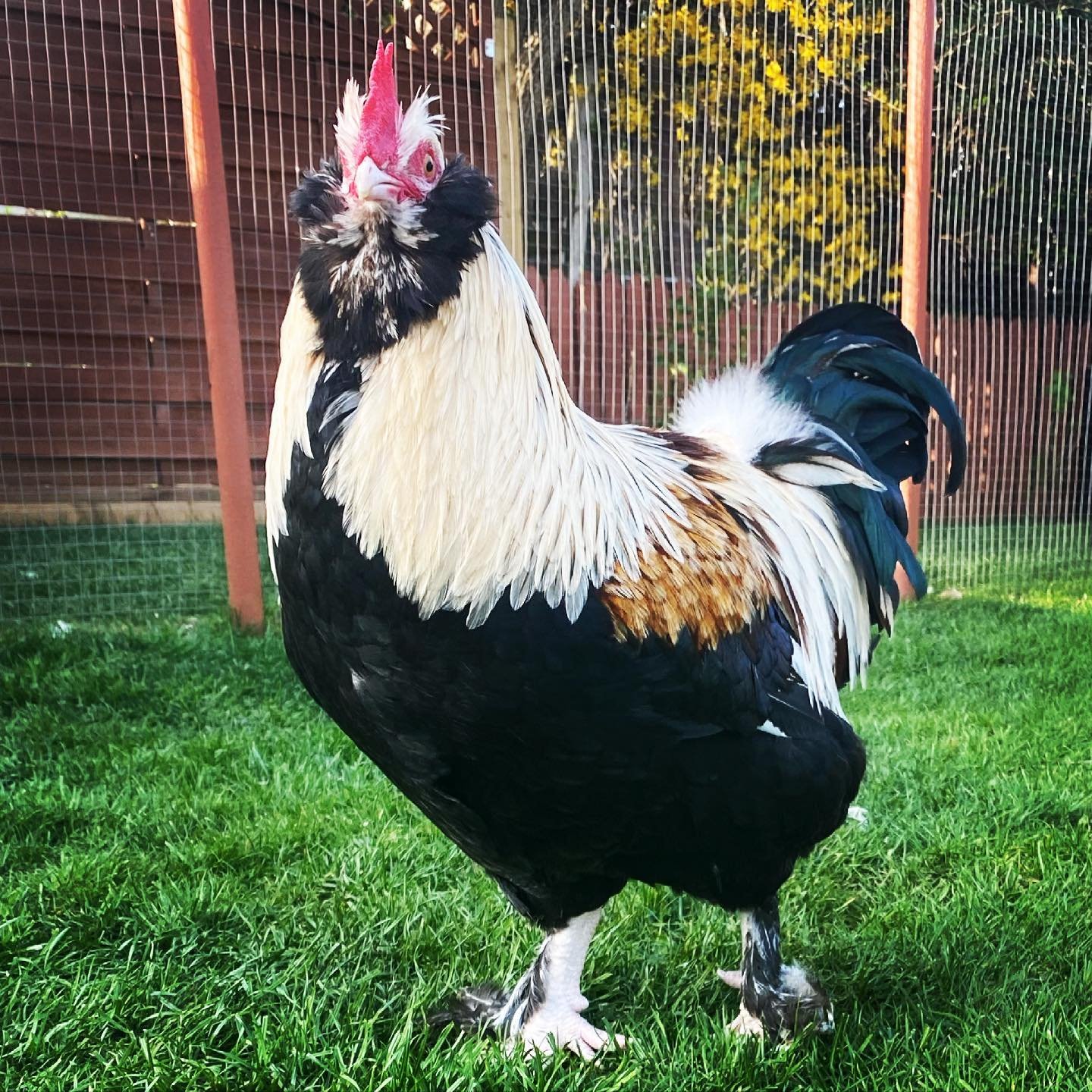
They are medium to large-sized birds with deep, compact bodies, fluffy plumage, and feathered shanks and toes. These birds are bred in several varieties, such as black, laced blue, buff, cuckoo, salmon, white, and ermine.
The roosters can get 9–11 lbs in 5-6 months.
These are friendly, social, and easily kept. Keepers enjoy interacting with and handling birds in backyards.
Temperament: Exceptionally friendly and calm
Egg Fertility: Moderate
Ideal for: Family-friendly homesteads and ornamental flocks
16. Welsummer
Welsummers are medium-sized birds with a broad back, full breasts, and large tails.
They also highlight a single red comb, medium wattles, and almond-shaped ear lobes attached to a short dark yellow beak.
You can find these birds mainly having red partridge feather patterns, meaning reddish-brown plumage with yellow legs. There are gold and silver duckwing varieties too, by the way.
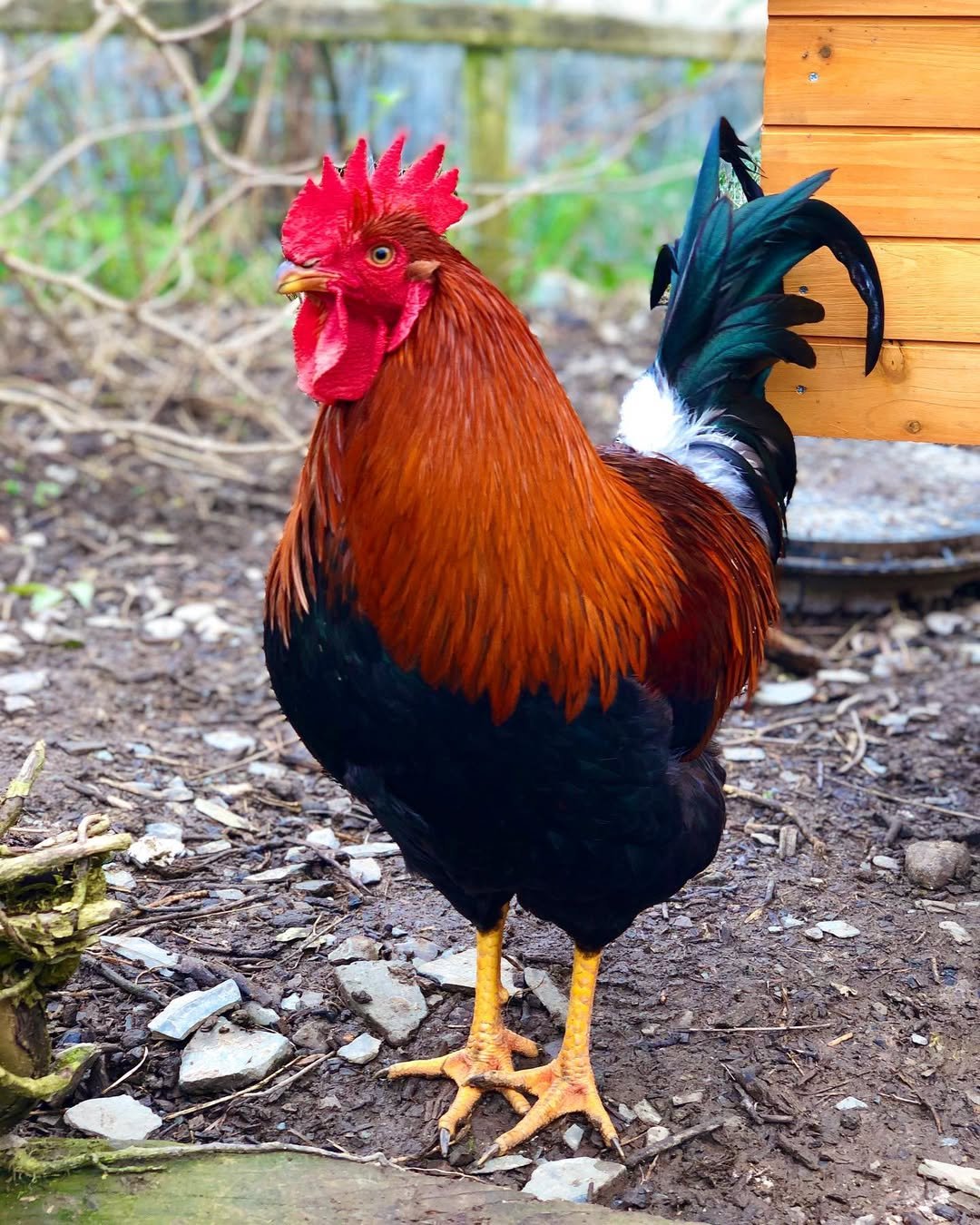
The roosters can be good table birds weighing 7-8 lbs.
Keepers can find it easy to handle Welsummers as chickens are a friendly, calm and intelligent. The fowls enjoy free range and forage for foods.
The roosters can get their fertility age by 6 to 12 months and remain fertile for 2 years.
Temperament: Smart and alert
Egg Fertility: Excellent
Ideal for: Predator-heavy areas
17. Campine Rooster
I have enlisted Campine roosters with compact body, square breast, long back, and sweaper like tail held high.
They are small sized birds weighing only 5-6 lbs.
These have a slender, V-shaped appearance and close-fitting plumage.
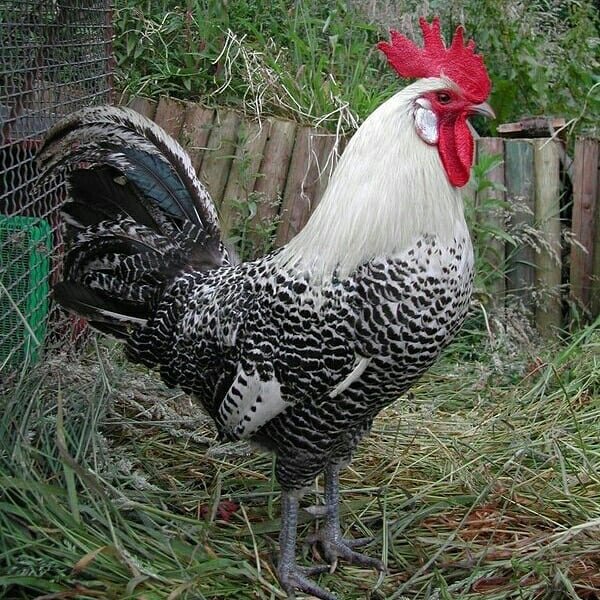
The roosters are hen-feathered birds. This means, males have short neck and saddle plumage and lacks sickles in the tail feathers, only having a slight curve, similar to females.
They are either golden or silver in varieties.
Campine roosters are showy boys who enjoy swaggering their stuff and lure girds. Also, they are aloof sometimes or friendly othertimes.
They mature and able breed in 20 weeks.
Temperament: Independent and lively
Egg Fertility: High
Ideal for: Warmer climates and free-range setups
18. Sumatra
I know, many dislike keeping sumatra chickens in backyards. That’s the choice, my friend. Experienced and hobby farm owners love these birds around their enclosures.
I tell you, the birds are not aggressive often but cockerels can be gitated during breeding season. So, they are breed for game purposes.
Sumatras are beautiful birds with long flowing curves, full and lots of tail feathers, giving a rich green sheen.
They highlight a dark red pea comb, wattles, earlobes, and leaden gray shanks.
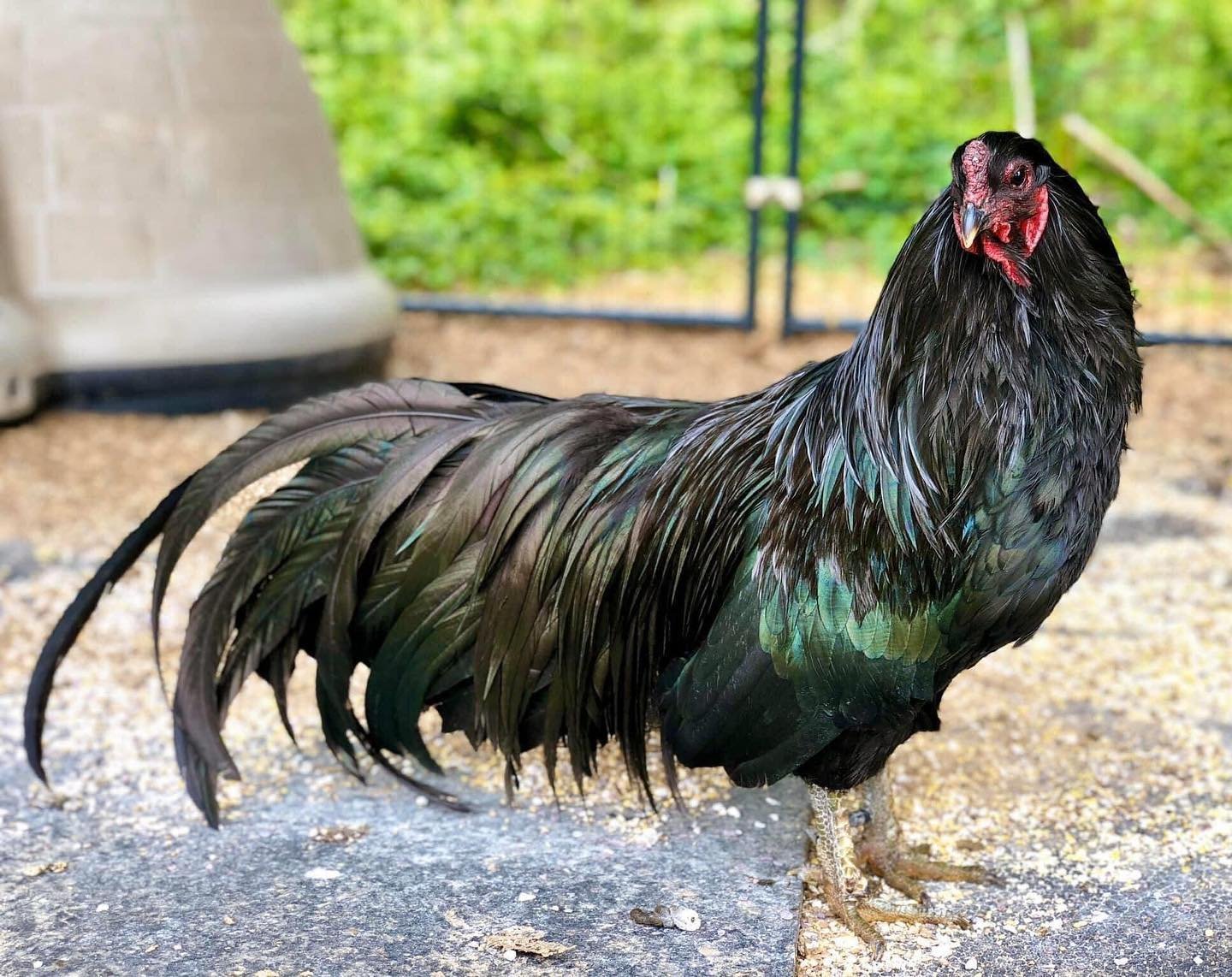
However, they are only 5 – 6 lbs in blue and black plumage. They are slow maturing roosters that may take almost 2 years to reach full growth and maturity.
Anyway, sumatras are active, hardy, and free-range birds.
Keepers require lots of skills as they can fly and jump to a few distances.
Temperament: Flighty, agile, and active with a strong personality
Egg Fertility: Moderate
Ideal for: Ornamental and sports purposes
19. Old English Game Bantam
This bantam is a cute yet agile, strong breed that has historically been known for beauty and sports purposes.
Old English Games have compact, muscular body, wide shoulders, and long legs. They own a slender carriage and chest puffed out to look bigger.

This build makes the birds proud, alert, and active.
They are available in several varieties, including black, dun, white, brown, red, and others.
These roosters are only 2 lbs but don’t like to be confined, requiring free space. They are hardy birds and want to roam and forage outside.
The Old English Game roosters are slow to mature birds and have fighting instincts from a very young age.
Also, they are aggressive and noisy birds, so you need to be careful and skilled to handle these roosters.
Temperament: Bold, energetic, and aggressive
Egg Fertility: Moderate
Ideal for: Sports and ornamental purposes
20. Silkie
One of my favorite cute roosters!
I don’t know about others, but I like silkies for their various-colored plumage, which is available in black, blue, white, partridge gold, and grey.
They are all covered with fluffy feathers, making them look like a living powder of puffs.
Their feathers are soft and look like fur.

Silkies own adorable crest on their head that veil skulls and comb. Even eyes and beaks are barely visible.
These feathers grow longer and start flowing backward from the head and curl around the face of the rooster.
You can expect your roosters to be 4 lbs.
Don’t worry. These small birds are calm, docile, unharmful, and friendly. Especially your children’s will love playing with them.
I often find roosters crowing from 4 to 20 weeks.
Temperament: Exceptionally calm and friendly, making them great pets.
Egg Fertility: Moderate
Ideal for: Backyard homesteaders, families with children, and ornamental flocks
Final Thoughts
After learning about some rooster breeds and their characteristics, you need to distribute them to the flock.
You can assign one rooster per 8 – 10 or 12 if the boy is highly fertile and capable of handling the large flock. If not, 1 – 5 hens per rooster is okay.
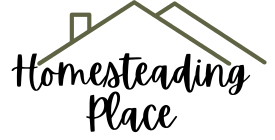
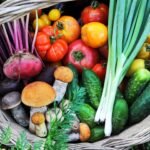

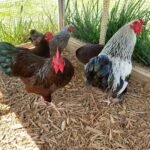
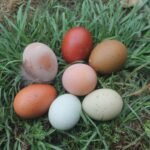
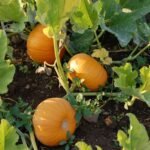

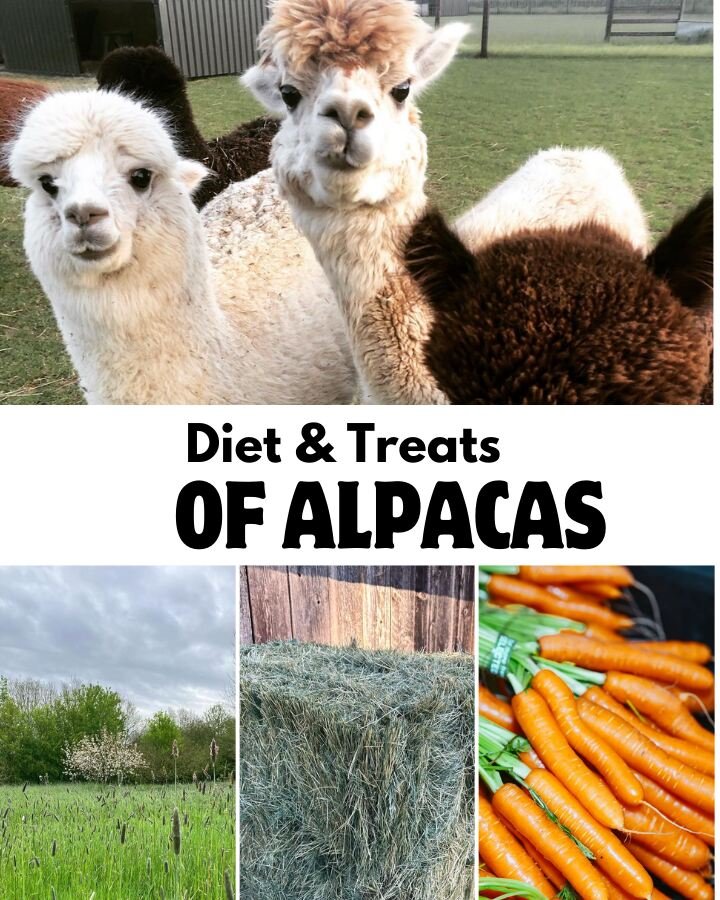

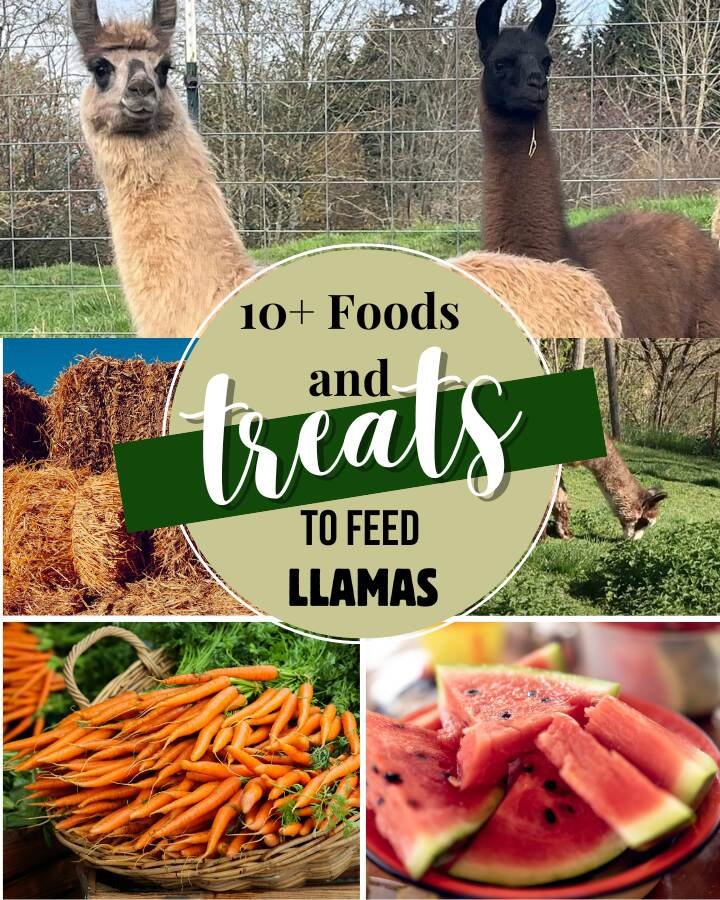
Leave a Reply